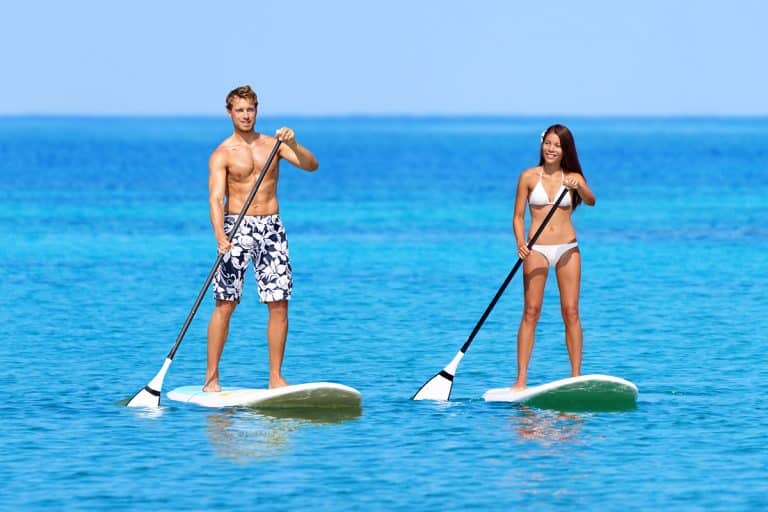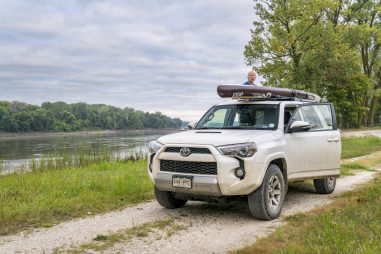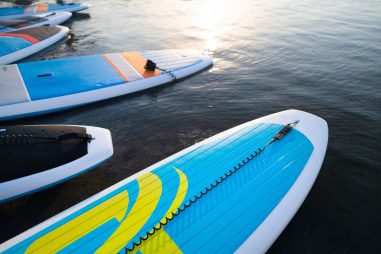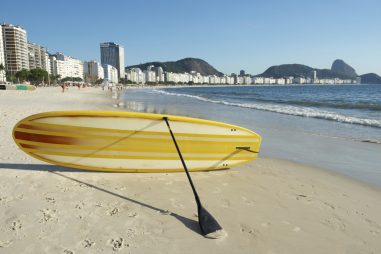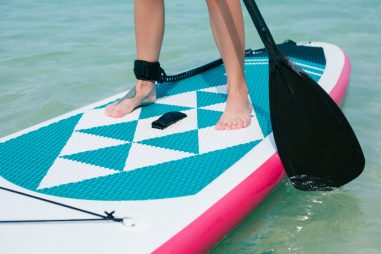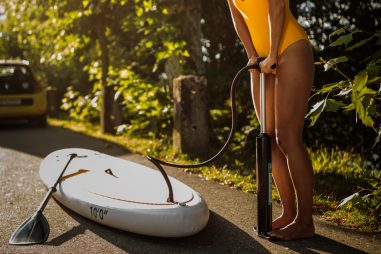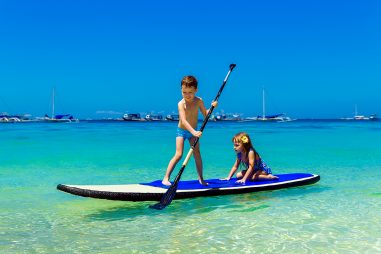History suggests that stand up paddle boarding or SUP has been around forever but compared to other water sports, it is considered to be fairly new. Now that it has been progressively becoming popular, people of all ages from around the world come to experience the sport and end up loving it.
What Is SUP Short for?
Nope, SUP does not mean what’s up (as most cool people would say). SUP is actually an acronym for Stand Up Paddle Boarding. It is a water sport that is gaining popularity all over the world.
Stand up paddle boarding is a very versatile activity that you can do anywhere there is a body of water—bays, lakes, rivers, and oceans, among others. You can do it alone, with a friend, and sometimes, even with your pets!
Why Are Paddle Boards Called SUP?
Paddle boards are called SUP because, as the name suggests, you stay upright on the board for the most part of the activity. While standing at your full height on the board, you would have a more unique vantage point of what is ahead of you and what’s under the water.
While surf boards and paddle boards resemble each other, paddle boards are designed to glide over waves while surf boards are meant to ride with and along with the waves.
What Activity Is SUP?
Stand up paddle boarding is considered to be an outdoor water sport activity. It is also known as a kind of board sport, much like surfing.
SUP is great as both a solo sport and a tandem sport. With your paddle board, you can cruise through the waves in solitude, but you can make it a lot more fun by also bringing your friend, your family member, your pet, or your significant other along for the ride.
Is SUP a Sport?
SUP is most definitely a sport activity, and it’s a professional sport at that. While some people do it as a leisure activity, others take it a notch higher and actually compete and even professionally teach beginners.
There are also associations dedicated to promoting stand up paddle boarding. Some of the biggest paddling associations include the Professional Stand Up Paddle Association or PSUPA, World Paddle Association, Stand Up Paddle Athletes Association, British Stand Up Paddle Boarding Association or BSUPA, and Stand Up Paddle Industry Association.
When Did SUP Become Popular?
While SUP seems to have been an activity that ancient humans have enjoyed ages ago, it only exploded in popularity in the 2000s. It is only during this time that the sport was introduced as the modern sport that we now know, enjoy, and love.
The root of the sport dates back to 18th century Hawaii. But it cannot be concluded when and where SUP specifically started or was invented as the activity has been a part of the history of many countries including Africa, South America, Israel, Brazil, and East Anglia in the United Kingdom.
We may never know when and where it truly started but one thing is for sure: stand up paddle boarding is here to stay.
How Fast Can a SUP Go?
On average, you can move across the water while paddling at around 3.5 to 4.5 miles per hour. This speed is enough if you want a nice and relaxing movement on the water.
Beginners, understandably, move a lot slower especially if it is their first time on a paddle board. If you are into recreational paddling, you can go slower to conserve your energy for longer trips.
Professional paddleboarders move at an average of 8 miles per hour. They can go even faster if they chance upon good weather and water conditions.
How Do I Make My SUP Faster?
Even if you want to move full speed on your paddle board, there is no sure-fire way or technology to make your SUP move faster. This is because there are several factors that affect how slow or how fast your paddle board moves.
Some of which rely heavily on you as the paddler, while some are environmental factors that you don’t have control over.
Some environmental factors include the following:
- Wind Speed: This can make or break your paddling activity. Even if you want to go fast, if you chance upon gusty headwind, it would be hard for you to move faster and farther. It is also especially hard if the wind is blowing against you and your board. Always make sure to check the wind speed in your area of choice to know if you would be able to paddle fast.
- Water Conditions: So, your location doesn’t have a gusty headwind, but alas the water condition is not at all great. If that’s the case, then this may cause your paddling to go slow as well. Bad and unmanageable water conditions can come in many forms such as big swells, debris on the water, and low tide or lack of depth in the water.
- Current: This is yet another thing that you should pay attention to. Maybe the water is deep enough and there is no debris littering the surface of the water but is the tide strong enough to sweep you inland? If it is, then maybe you should postpone your SUP activity as this can be dangerous.
Now that we’ve tackled the things that mother nature can put in the way of your paddling, let’s talk about the factors that you, as a rider, have some control over.
- Fitness level: Is this your first time paddling but you still want to go fast? Maybe you bit more than you can chew. If you get winded easily even while walking, then try to build your stamina for paddling before thinking of racing with another rider. You also need to have upper body and core strength to be able to paddle fast enough.
- The distance that you want to cover: You should take into consideration the distance that you want to cover. If you want to reach an island that is obviously far, then you better calculate your rate of speed. If you go too fast too early, you might tire your arms out halfway and your speed can significantly go down.
- Board of choice: Your board also affects your speed. There are several types of paddle boards, each with its own pros and cons. Before even deciding on buying one, you should be able to figure out your riding style and riding goals.
While there is a lot to consider before you become the world’s fastest paddler, it doesn’t mean that it’s impossible. You should just be wise enough in choosing your location and you should always pay attention to your health and fitness.
Which Is Faster – a SUP or a Kayak?
Kayaks are known to be generally faster than SUP. However, it’s not always the case and there are still other factors to consider.
SUPs can have other advantages in other disciplines that can have kayaks beat.
Can a SUP Keep Up With a Kayak?
If we are talking about straight-line speed, then kayaks win against SUPs hands down. If we are comparing a kayak and a SUP of equal length, kayaks have SUPs beat as well.
But SUPs also beat kayaks in other categories. Recreation or whitewater kayaks can never keep up with a downwind or race stand up paddle board.
Should I Get a Kayak or a SUP?
There really is no concrete answer on whether you should get a kayak or a SUP because one is not better than the other. Before getting either, you should be clear on why you are getting one.
Hands down, SUP is more portable and accessible compared to kayaks. Aside from that SUP is also very adaptable. SUP has also more health benefits because it allows for a full body workout and they are also very easy for beginners.
Kayaking, on the other hand, can be more chill and relaxed. It is also very easy to learn and is safe for people of all ages.
Whether you choose to get a kayak or a SUP, it should support your riding goals and riding style.
How Far Can You SUP in a Day?
The distance that you can paddle in 24 hours depends on many things including your fitness, skill level, water and water conditions, and wind speed, among many others. While one can cover a distance of a few miles, others can go as far as reaching a hundred miles.
One of those who were able to cover a great distance is Bart de Zwart. de Zwart is known to be the record holder for the greatest distance covered using a stand up paddle board in 24 hours.
On May 30, 2017, de Zwart covered a whopping 193.9 kilometers or 120.42 miles in just a day of paddling in flat water on Lake Biel located in Erlach, Switzerland. Prior to this successful attempt, the Dutch paddler has been famous because of his endurance paddle expeditions.
Can You SUP in the Rain?
Rain or shine, riding your paddle board is always a good idea. Not only is paddling in the rain a new experience but it is also great if you want to improve your skills.
While it is great paddling when the sun is out and the weather is amazing, it is a learning experience when you set out in the rain. But as always, do it safely and bring a friend to monitor your safety and progress.
Can You SUP in the Winter?
One of the many great things about SUP is that you can do it every day of the year and in all seasons. SUP is great during the summer but riding your stand up paddle board in the winter is a whole ‘nother level.
If you plan on paddling during the cold months, here are some tips that you need to keep in mind.
- Always remember to stay close to the shore. Hypothermia is a real thing, people! And if you ever fall in the cold, cold water, you should be able to get back on land quick enough before you freeze to death.
- You must always use a SUP leash. It doesn’t matter what season it is, you MUST always wear your SUP leash. In case of falling, the lease will make sure that you are never far from your board (aka the thing that can save you in the water!).
- Wear winter SUP attire. Your swimsuit is of no use come winter, so instead make sure to wear several layers of clothing that will protect you from the wind and the cold. Running tights are awesome to combat the cold. Make sure that your feet and hands are protected by wearing winter shoes or winter boots, and a pair of gloves.
- Always check the weather forecast. The weather can change very quickly especially during the winter months. If the forecast says there is a possibility of snow, call off the activity, stay inside, and drink that hot cocoa.
- Stay in water. During the winter months, portions (if not the whole body of water) may be frozen. Make sure to stay off of these frozen portions and do not paddle around floating chunks of ice.
- Never paddle alone. This reminder is not only for the winter months, but this applies to all seasons, every day of every year.
Can You SUP on a River?
You can most definitely ride your paddle board on a river. However, this may come with considerations. You see, rivers often have a variety of conditions. On one end, the water may be flat and calm while in the middle it can be rough.
If you want to try river SUP, it is recommended that you use an inflatable SUP board that can withstand all sorts of conditions.
Where Can I SUP in the UK?
There are a lot of SUP locations to choose from in the United Kingdom. You can SUP in the ocean and various canals, rivers, and lakes.
Here are some of the most amazing places for SUP in the UK.
- Black Rock Sands in Gwynedd
- Wast Water and Coniston Water in Cumbria
- Penzance in Cornwall
- Loch Harport in the Isle of Skye
- River Wye in Herefordshire
- Hickling Broad in Norfolk
- Glencoe in the Scottish Highlands
- Loch Tay in Perthshire
- Bath in Somerset
- Anglesey in Wales
Can I SUP on the Thames?
SUP is an amazing activity to do in the River Thames. It is recommended to join a paddling club or organization if you want to experience paddling in the tidal Thames.
It is imperative that you follow the Paddling Code which was written by the Port of London Authority or LPA with the recommendations of some paddling organizations in the Thames.

